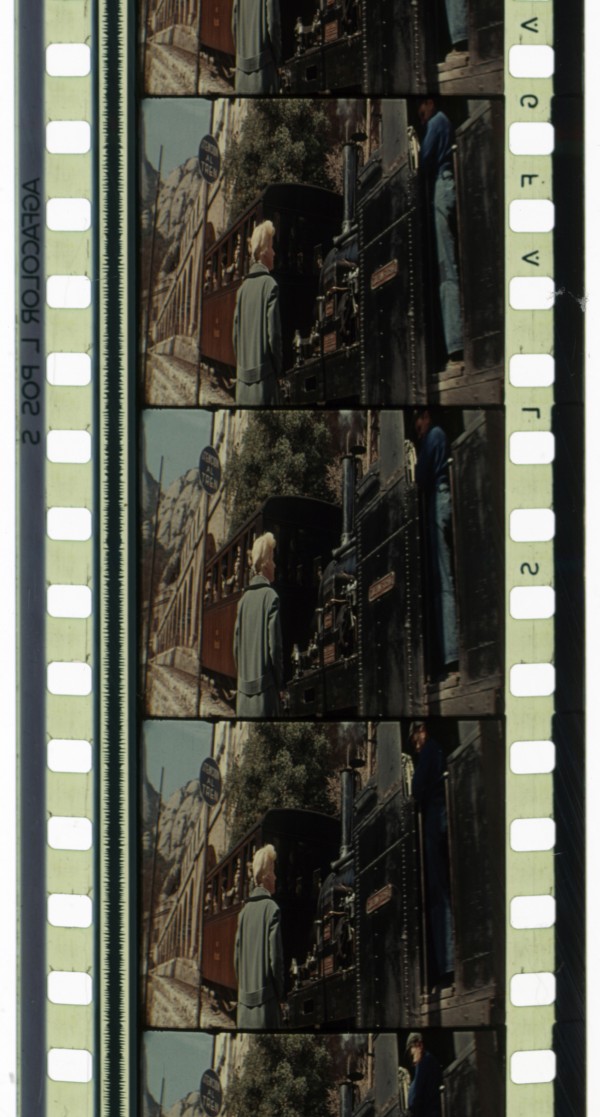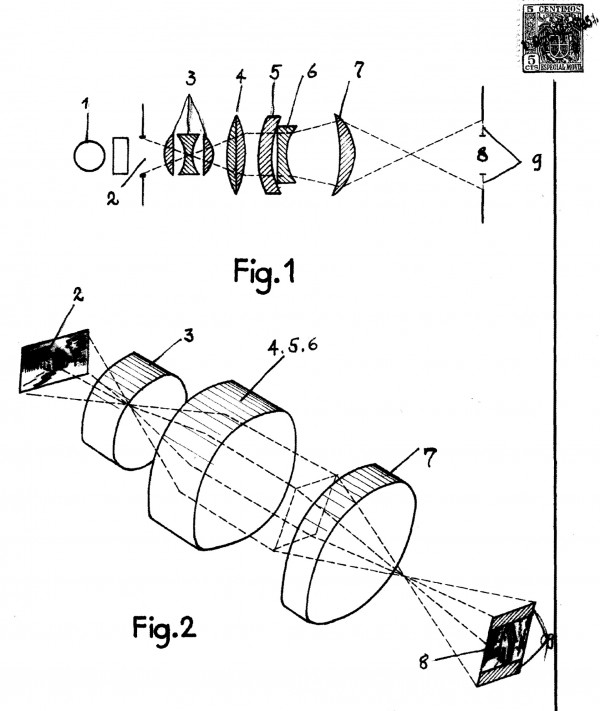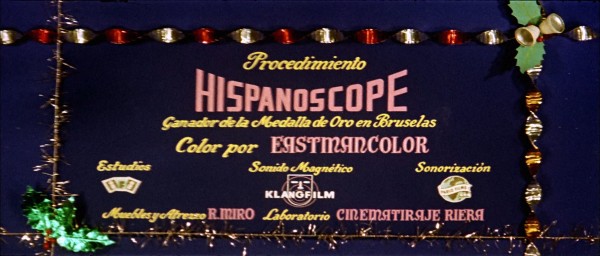A Spanish anamorphic image-capture system from the late 1950s, intended as a response to the growing widescreen market in Europe.
Film Explorer

Cumbres luminosas – Montserrat (1957). A widescreen image with an aspect ratio of 2.35:1 was anamorphically-squeezed horizontally into a narrower film frame. The image was unsqueezed again in projection.
Filmoteca Española, Madrid, Spain.

Cumbres luminosas – Montserrat (1957). This film was photographed and released in Agfacolor with mono optical sound.
Filmoteca Española, Madrid, Spain.
Identification
Color or B/W.
Prints likely display standard Ansco, Agfa or Eastman Kodak edge markings.
1
Hispanoscope prints were released in B/W, Anscocolor, Agfacolor, and Eastmancolor. Many of these prints are now likely to be suffering from color fading.
Hispanoscope
Variable area optical sound.
Color or B/W.
Negatives likely display standard Ansco, Agfa or Eastman Kodak edge markings.
History
Although there had been numerous attempts since the beginning of cinema to offer wider panoramas than the standard Academy screen frame, it was not until 1953 that Twentieth Century-Fox's CinemaScope revolutionized film production and exhibition. After the Spanish premiere of The Robe (1953) at the Palacio de la Música in Madrid, on May 7, 1954, inventors Ángel Pérez Palacios and Aurelio Lerroux decided to redirect their efforts from entertainment devices and optical toys to the production of anamorphic lenses. This anamorphic system was based on the development of cylindrical lenses that enabled the horizontal compression of the image onto a standard 35mm negative. When projected, another lens with an identical curve made it possible to uncompress the frame and obtain spectacular images.
Throughout 1955 and 1956, Ángel Pérez Palacios and Aurelio Lerroux registered a number of patents related to this field. The first one was a “new system of anamorphic lenses for photography and cinematography”, which specialized in capturing “large size images” through horizontal compression.
At the end of 1956, they filed a patent for a new anamorphic optical system that not only captured images, but also projected them with a 2.35:1 aspect ratio.
At the time, to test their invention in the field, they reached an agreement with the newsreel company No-Do to make two short films of about 12 minutes each: Reales sitios (1956) and Historia y cultura (1956). Both were made in AnscoColor, the American equivalent of the German Agfacolor, and assumed the role of tourist postcards.
For the first time, Spain participated in a World’s Fair – the 1958 Brussels World's Fair/Expo 58 (Salon International des Inventeurs, Bruxelles) – the first major World’s Fair following World War II. One of the gold medals went to Pérez Palacios and Lerroux's system, Hispanoscope. The press picked up the story – this being a time when the Franco regime was keen to seek international recognition in all areas of national output.
The Rotafilm-Hispanoscope company provided three anamorphic lenses of 50, 75 and 100 mm, suitable for any standard 35mm camera body, to interested production companies. In contrast to the costly foreign royalties, the domestic fee was 150,000 pesetas per film, with an occasional stipend of 35,000 pesetas extra for the lens operator, who oversaw the set-up of the lenses and ensured correct alignment.
Over the following two years, another five feature films were shot under the Hispanoscope brand, all Catalan productions in which the landscape – mountainous, coastal or urban – played a fundamental role. Cumbres luminosas – Montserrat (1957) took best advantage of the panoramic format, in both the exterior scenes and the documentary sequences shot in the Santa Maria de Montserrat abbey in Catalonia, Spain. The depth of field and the diagonal compositions were less common than the typical foreground layout found in other films from the same period.
The cycle ended with the cinematographic recording of a theatrical show La Copla Andaluza (1959), which announced itself as “Experimental Cinema-Theater”. Paradoxically, the last Hispanoscope production was shot flat with spherical lenses and released in both flat and anamorphic copies, depending on the exhibitor's choice. When the anamorphic image-capture method was discarded due to strong commercial competition from French and Italian anamorphic systems (with trade names such as Totalscope, Dyaliscope, Franscope and Supercinescope), Hispanoscope was kept as a laboratory-only optical technique. In addition, Rotafilm re-printed and re-released six Spanish films shot in Academy format between 1943 and 1956 as anamorphic copies, including El escándalo (1943), Mariona Rebull (1947), and El capitán Veneno (1950).
Selected Filmography
A feature film shot in Eastmancolor. Surviving copies have been preserved in flat Academy format rather than anamorphic widescreen.
A feature film shot in Eastmancolor. Surviving copies have been preserved in flat Academy format rather than anamorphic widescreen.
A feature film shot in Agfacolor.
A feature film shot in Agfacolor.
A short travel film shot in AnscoColor.
A short travel film shot in AnscoColor.
A B/W feature.
A B/W feature.
A B/W feature.
A B/W feature.
A short travel film shot in AnscoColor. The first production released in Hispanoscope.
A short travel film shot in AnscoColor. The first production released in Hispanoscope.
A feature film shot in Eastmancolor.
A feature film shot in Eastmancolor.
Technology
Hispanoscope consisted of a system of anamorphic lenses for photography and cinematography, patented by the owners of the company Rotafilm, S.A. The format specialized in capturing “large size images” through horizontal compression, “by virtue of the adoption of two optical systems composed of cylindrical or toric lenses, respectively 1 and -2, the first compresses the image in its horizontal axis, transmitting this resulting image to the second toric lens, of type -2, which compresses the image again”. The result, as in other anamorphic systems, was a double horizontal compression of the image, “with the effect that large visual fields can be reproduced on negatives of minimal surface area, thus saving material”.
To reproduce the original aspect ratio on the screen, the image was de-anamorphosed (uncompressed) through lenses attached to the projector, which were also provided by Rotafilm, or any other standard system available. The resulting aspect ratio was 2.35:1.
In addition, in 1956, Rotafilm conceived a new system that made it possible to attach “a plano-cylindrical or bi-cylindrical lens to the standard spherical lens of the camera or projector, so that it was not necessary to use compound lenses”. (Lerroux, Maíllo & Pérez Vaquero 1956)

Diagram of the compound lenses patented by Aurelio Lerroux and Ángel Perez Palacios in 1955.
Lerroux y Romo de Oca, Aurelio and Ángel Pérez Palacios. 1955. Un procedimiento de obtención de películas cinematográficas de proyección en pantallas de tipo panorámico a partir de películas del tipo normal, Spanish Patent ES0219630, filed January 19, 1955, patented June 16, 1955. https://consultas2.oepm.es/InvenesWeb/detalle?referencia=P0219630
References
Aguilar, Santiago (2016). “Hispanoscope: pantalla ancha con patente española”, Secuencias, 40: pp. 31–61.
Belton, John, Sheldon Hall & Steve Neale (eds.) (2011). Widescreen Worldwide. Bloomington, IN: Indiana University Press.
Del Amo, Alfonso (1996). Inspección técnica de materiales en el archivo de una filmoteca. Madrid: Filmoteca Española: pp. 84–86.
Pérez Palacios, Ángel (1958). Las nuevas técnicas del cine. Madrid: Centro Español de Estudios Cinematográficos.
Patents
Lerroux Romo de Oca, Aurelio and Ángel Pérez Palacios. 1955. Un procedimiento de obtención de películas cinematográficas de proyección en pantallas de tipo panorámico a partir de películas del tipo normal, Spanish Patent ES0219630, filed January 19, 1955, patented June 16, 1955. https://consultas2.oepm.es/InvenesWeb/detalle?referencia=P0219630
Lerroux Romo de Oca, Aurelio and Ángel Pérez Palacios. 1956. Un nuevo sistema óptico, afocal anamorficador, para tomas y proyecciones, especialmente para pantallas panorámicas, Spanish Patent ES0224739, filed October 29, 1955, patented January 1, 1956. https://consultas2.oepm.es/InvenesWeb/detalle?referencia=P0224739
Compare
Related entries
Author
Santiago Aguilar worked as a documentalist at the Filmoteca Española between 1985 and 1995 and has since continued to collaborate with the institution as a researcher. In collaboration with Felipe Cabrerizo, he has undertaken various works related to 20th century Spanish and South European cinema and popular culture. He has written books and articles on little known aspects of the history of Spanish cinema — for example, Operación Torremolinos: El cine español de superagentes (1965-1967) and Sagitario Films, oro nazi para el cine español (winner of the Muñoz Suay award from the Spanish Academy of Motion Picture Arts and Sciences), both published in 2021, and Cinefotocolor, el color de la autarquía, published in 2022 — and gives classes in the Archive program of the Elías Querejeta Zine Eskola in San Sebastian, Spain.
Filmoteca Española.
Aguilar, Santiago (2024). “Hispanoscope”. In James Layton (ed.), Film Atlas. www.filmatlas.com. Brussels: International Federation of Film Archives / Rochester, NY: George Eastman Museum.



